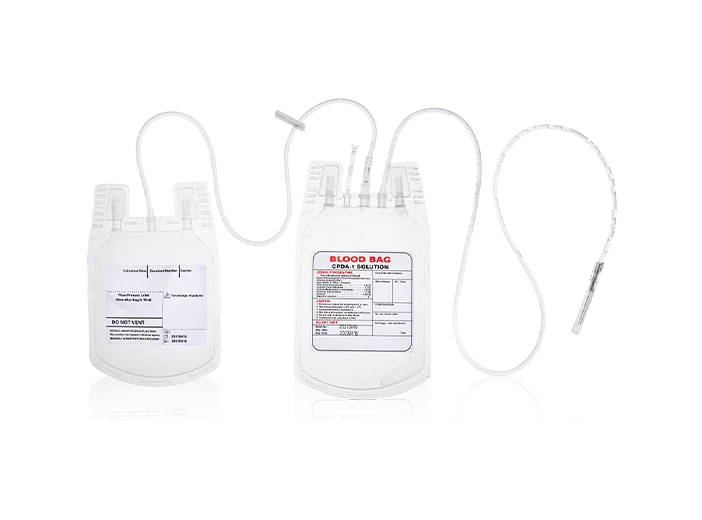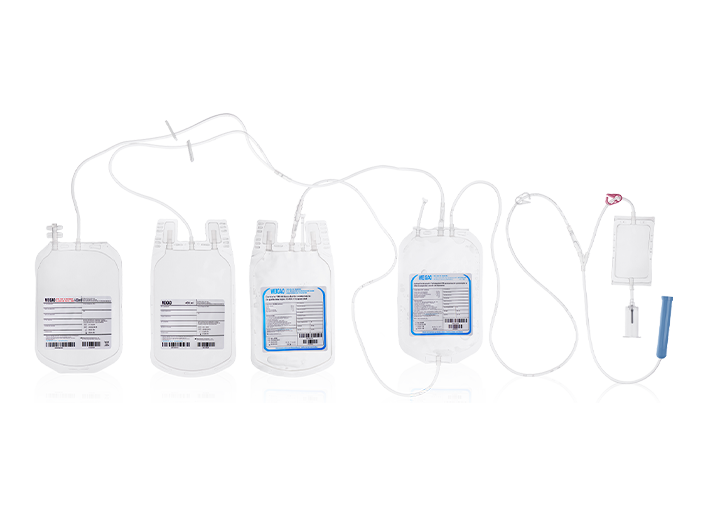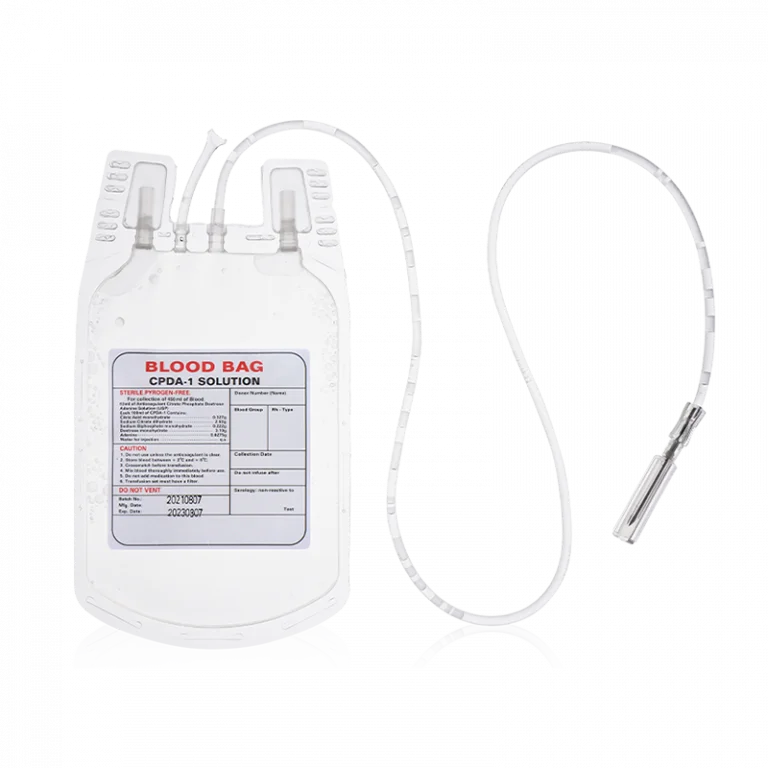Blood is vital to lifesaving actions in emergency medical care. It is not only used to treat various diseases and injuries, such as blood loss and anemia but also plays an irreplaceable role in first aid and surgery.
High-quality blood collection bags are containers for collecting, storing, and transporting blood, essential to blood management and delivery. These bags guarantee the safe and quality transfer of blood from donor to patient for transfusion.
This article will explain blood collection bags and the factors affecting their quality.
Understanding the Blood Collection Bag
Understanding blood collection bags is crucial for healthcare professionals.
Here is a detailed introduction to the classification of blood collection bags, the importance of blood bag quality, and the role of CPDA in blood bags:
Classification of Blood Collection Bag Types
Blood collection bags can be classified into different types based on material and design to meet different clinical needs.
According to the production materials, it can be divided into flat film blood bags and traditional film blood bags.
- Flat film blood bags: Made of polyvinyl chloride (PVC) material. They are widely used for good sealing, anti-rupture, and anti-permeability, and they are suitable for high-safety blood collection and transfusion situations.
- Traditional film blood bags: Traditional blood bags are made of glass and can be reused through cleaning and disinfection. However, it is prone to intercross infection if it cannot be thoroughly sterilized.
Furthermore, these bags can also be divided into these 4 types according to their design:
- Single blood bag: It’s a whole blood bag used for collecting, storing and transfusing whole blood.
- Double blood bag: Used for collecting and separating whole blood into two different blood components, plasma and red cells.
- Triple blood bag: Separate whole blood into three blood components, such as red blood cells, platelets, and plasma.
- Quadruple blood bag:Separate four components from whole human blood.
These disposable blood bags are popular in blood banks and hospitals because they effectively store and separate blood and avoid intercross infection, providing patients with safe and efficient blood transfusions.
Importance of Blood Bag Quality
High-quality blood collection bags lower transfusion hazards. First, they guarantee blood bag sterility and integrity to avoid microbiological contamination and infectious disease.
Second, high-quality materials decrease immune reactions and adverse transfusion reactions for patient safety, as they ensure the integrity and stability of blood components.
Third, these bags’ quality control includes obvious labelling to ensure blood type matching and avoid incorrect blood transfusions. In addition, high-quality blood bags can ensure the correct separation and storage of blood components that need to be separated and processed.
The Role of CPDA in Blood Bags
Citrate Phosphate Dextrose Adenine (CPDA) is a commonly used anticoagulant and preservative in blood bags.
Platelets in the blood will form clots after entering the blood collection container. CPDA can prevent this process. It combines with calcium ions to form insoluble precipitates, thereby preventing platelet aggregation and coagulation.
In addition, CPDA can protect other components in the blood, such as red and white blood cells, from damage. These CPDA blood bags can preserve red blood cells for up to 35 days at 2℃-6℃.
Key Factors Affecting the Quality of Blood Bags
Blood bag quality is crucial for ensuring the safety and effectiveness of blood transfusions. So, what will affect blood transfusion safety? Here is a detailed summary:
Material Safety
Biocompatible, non-toxic, and high-quality material must meet CE and RoHS criteria for blood collection bags.
To prevent plasticizers from leaching into stored blood and harming its safety, the blood bag materials, including PVC, PE or PP, must be chemically stable and degradation-resistant.
In addition, high-quality blood bags also show resilience during refrigeration, which can prevent bag breakage during transportation and storage.
Furthermore, the materials must be transparent to visually examine blood quality and volume. The bag’s surface must also limit cellular adherence to safeguard blood component viability and function.
Production Process
Blood collection bag production demands accuracy and cleanliness. To protect blood bag sterility and integrity, leak-proof seams are created using high-precision extrusion and welding.
Using quality inspection equipment to identify minor seal imperfections that might affect blood safety. Using integrated filters during manufacture facilitates blood component separation and lessens transfusion-related problems.
Production facilities must follow GMP and have clean rooms to avoid airborne particle and microbe contamination.
Compatibility
Blood collection bags must be compatible with blood components and blood transfusion equipment, including needles, spikes, and tubing. It confirms a safe and efficient connection that decreases leaks and contamination.
In addition, the inside design should be made of soft, flexible, and stable materials to avoid mechanical stress and hemolysis during collection, storage, and transfusion.
The bag’s chemical composition inhibits adverse reactions with blood components for better transfusion efficacy. It stores platelets, red blood cells, and plasma without structural or functional changes.
Packaging and Sterilization
Packaging and sterilization, which affect blood product safety and availability, are the last essential elements affecting blood collection bag quality.
Triple-layered, tear-resistant, and moisture-proof packaging protects the bags from germs, fungus, and dirt and resists physical damage.
Ethylene oxide sterilization kills microbes while keeping the material’s features and blood compatibility. This process fulfils regulatory criteria and does not damage the bag’s material integrity or blood purity.
WEGO Medical’s Blood Collection Bag Solution
WEGO Medical, a blood bag supplier, offers novel blood collection bags for multiple clinical applications and complete blood management solutions.
Our product range comprises single, double, triple, and quadruple blood bags with CPDA-1 anticoagulant and preservative solutions to increase blood component availability. With the advantages of high safety, good stability and strong convenience, these blood bags are commonly used in clinical practice.
We also provide a leukocyte reduction filter that lowers transfusion-related immune responses by cutting leukocyte presence. Our medical incubator helps to store and transport sensitive medical items effectively.
Through methodical design and quality control, we guarantee that each blood bag fulfils or surpasses the blood storage and transfusion requirements. It indicates our consecration to bettering transfusion medicine patient care and protection.
Conclusion
Blood collection bags play a crucial role in modern medicine. It not only provides valuable resources for first aid and surgery but also ensures the safe storage and use of blood.
WEGO Medical is a professional and experienced medical device manufacturer. Our variety of products, from high-quality CPDA blood bags to medical equipment, confirms our leadership in holistic healthcare solutions. We customize our approach to the healthcare industry to provide our partners with the most trustworthy and safe medical supplies.
Contact us for more specific information about high-quality bags for blood collection!











